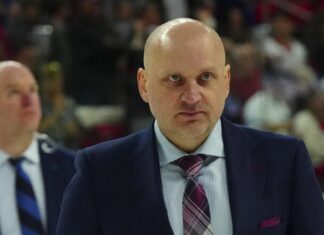Everything is coming up aces for the Toronto Maple Leafs in January. The club has won six straight games to not just climb back into the playoff race but establish a secure foothold. And if the riches weren’t embarrassing enough, the Leafs also have junior hockey’s hottest scorer, Connor Brown.
Brown, the 156th selection in the 2012 NHL Entry Draft currently leads the Ontario Hockey League in scoring with 31 goals, 61 assists for 92 points in 45 games this season. He holds a 10-point lead over his closest competitor (teammate Dane Fox) and is on pace to challenge the 140-point mark in the OHL for the first time since Patrick Kane in 2007.
Since the OHL season began in October, Brown has gone from being a longshot prospect (ranked 21st by PPP and 18th by TLN in the 2013 offseason) to the club’s brightest draft pick. His play so far this season earned him a three-year entry level contract; and his omission from Canada’s WJC team came as a shocker to anyone who understands that winning teams tend to outscore losing teams.
While interning at the Hockey News in the spring of 2012, Brown’s name first came to my attention while working on their draft preview issue. While playing on a comically bad Erie Otters team, Brown racked up one of the worst +/- scores of any player in any league ever with a -72. Indeed, if I recall correctly, he was something of a laughing stock among the staff.
Never mind that +/- is a mostly pointless stat; Brown was one of the few good players on a team that literally gave up twice as many goals as they scored (169 GF vs. 338 GA, a hilarious -169 differential). Lost in the negative zone was that Brown led those woeful Otters in scoring in 2012. And repeated that feat in 2013. And seems hell bent to lead the whole league for the three-peat. Heck of an encore after being written off so completely.
Despite making headlines for the wrong reasons prior to his draft, the Leafs certainly have had a precise plan in place to see Brown develop into a top six guy in the NHL. In a July 2013 interview, Leafs Player Development head Jim Hughes said this about Brown:
He’s an interesting one because his skill sets are so high. He can find the late people, he can find the seam, he can find the backdoor people and he can buy time and space. He’s got really soft hands and a very creative brain.
And then you put him with McDavid for another year. I think Connor finished around 80 points in the OHL? So, when you play him with McDavid he should be in the 100-point range. Maybe we keep in junior for an overage year. Maybe he’ll be in the 110-120 point range. We’re not sure. He’s got a high ceiling and we’re going to continue to find out how far he can take this, because he’s a second line player, not a 3 guy or a 4 guy. He’s a 2 guy. And we’ll see what kind of production he can put up this coming season.
With Connor we’re looking 24 months down the road. It’s not a quick fix with him. We’re looking to put 6-8 pounds on him this year, maybe another 6-8 pounds on him next year. We’re looking long term and if we allow him that big window of another 24 months we might have something.
It’s safe to say that Brown has exceeded everybody’s expectations for him, even if a 100-point season did seem insane (instead of prophetic) at the time. Clearly the biggest goals from the Maple Leafs’ standpoint are to see Brown add to both his point totals and his waistline. But having nearly superseded his projected point totals in his draft +2 year with 23 games remaining, it’s safe to say Brown is ahead of the Leafs’ internal schedule. He’ll almost certainly start with the Marlies for the 2014-15 season, as his offensive pedigree will be a welcome addition to Spott’s roster.
But will he be an NHLer? Or is he is merely an exceptional OHLer? I took a quick peak at the last 20 years of OHL leading scorers, their ages, draft status, points and games played:
| Year | Name | Age | Draft+ | PTS | NHL GP |
|---|---|---|---|---|---|
| 2014 | Connor Brown | 20 | 2 | 92 | 0 |
| 2013 | Vincent Trocheck | 19 | 2 | 109 | 0 |
| 2012 | Mike Sgarbossa | 19 | 2 | 102 | 6 |
| 2011 | Tyler Toffoli | 19 | 1 | 100 | 43 |
| 2010 | Taylor Hall | 18 | 0 | 106 | 215 |
| 2009 | John Tavares | 18 | 0 | 104 | 341 |
| 2008 | Justin Azevedo | 20 | 2 | 124 | 0 |
| 2007 | Patrick Kane | 18 | 0 | 145 | 497 |
| 2006 | Rob Schremp | 20 | 2 | 145 | 114 |
| 2005 | Corey Perry | 20 | 2 | 130 | 625 |
| 2004 | Corey Locke | 20 | 2 | 118 | 9 |
| 2003 | Corey Locke | 19 | 1 | 151 | 9 |
| 2002 | Nathan Robinson | 20 | 3 | 110 | 7 |
| 2001 | Kyle Wellwood | 18 | 0 | 118 | 489 |
| 2000 | Sheldon Keefe | 20 | 1 | 121 | 125 |
| 1999 | Peter Sarno | 20 | 2 | 130 | 7 |
| 1998 | Peter Sarno | 19 | 1 | 121 | 7 |
| 1997 | Marc Savard | 20 | 2 | 130 | 807 |
| 1996 | Aaron Brand | 20 | 3 | 119 | 0 |
| 1995 | Marc Savard | 18 | 0 | 139 | 807 |
| 1994 | Jason Allison | 19 | 1 | 142 | 552 |
Here are some takeaways from the above list:
– Purely by the numbers, nine of the previous 20 OHL leading scorers went on to play at least 100 games. When all is said and done, it seems likely that Tyler Toffoli will also achieve that rank, while Sgarbossa and Trocheck are still too young to guess. But roughly 50% of leading scorers in the past 20 years played at least a season and a half in the NHL.
– 7 of the 9 leading scorers to play 100+ NHL games were first round picks. 3 of those 7 were first overall picks in their draft year.
– 5 of the 9 leading scorers to play 100+ NHL games did so in their draft year.
– 2 players led the OHL in scoring in an overage year (Robinson and Brand).
– Only 2 players (excluding Trocheck) never played an NHL game.
– Most of the above info doesn’t really help Connor Brown’s case
There appears to be a few distinct species of OHL scoring champs. First is the superstar talent that set the league on fire before they were drafted. Tavares, Hall, Kane would be the best examples of these guys. Guys that end up being posters on some kid’s wall.
On the other end are smaller guys taken in late rounds who lit up the league before flickering out into relative NHL obscurity. The Robinsons, Lockes and Sarnos of the world might torch the Erste Bank League, but their NHL dreams are long extinguished.
The third and final type is really an offshoot of the second. Later round guys like Wellwood and Savard who had distinct knocks to their game (size, speed and commitment etc.) yet clearly have a couple truly exceptional hockey skills (playmaking and puck skills) that allow them to become everyday contributors to NHL clubs.
Unfortunately, his age (and likely his now insanely good supporting cast in Erie) suggests that Brown’s road to the show will be a long one, more similar to those second and third types. But he’s already being afforded the opportunity to improve upon weaknesses like skating or defensive acumen with the Leafs training staff.
Yet for every Marc Savard comes at least one Aaron Brand or Justin Azevedo. So while Brown has provided nothing but optimism for Leafs fans since his selection, all he’s done is distinguish himself from young competition after his draft year.
In terms of an NHL timeline, it would behoove Leafs fans to remember Jerry D’Amigo, another sixth rounder who shot out the lights after the Leafs drafted him. Five seasons later and he’s only now cracked the Leafs lineup in a spot duty capacity.
But if you consider the process over the product, you can’t help but be hopeful. While it doesn’t sound particularly impressive to potentially play ‘only’ 100 NHL games, the Maple Leafs’ scouting staff’s ability to continue to unearth cheap, potentially NHL-calibre talent late in the draft speaks to its competence league-wide.
More importantly, this late round success could offset dubious, low-ceiling selections in the first round like Tyler Biggs and Frederik Gauthier. Because while it could be well argued that I’m being too negative about a guy tallying 2 points per game in junior, guys that can’t manage a point per game tend to have it worse.





















![Two Down, Two to Go for the Maple Leafs – MLHS Podcast EP91 [Now with Video]](https://mapleleafshotstove.com/wp-content/uploads/2025/04/maxresdefault-3-218x150.jpg)










